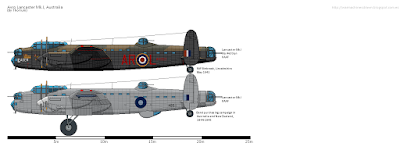The Avro Lancaster was a British four-engined World War II heavy bomber that was manufactured by Avro and designed by Roy Chadwick.
In the Royal Australian Air Force, it served with the next squadrons:
- No.460 Squadron: On October 1942 this squadron, based in the United Kingdom, replaced their Handley Page Halifax for the Avro Lancaster. Operating from RAF Binbrook, they took part in the aerial battle of Berlin, some support missions for the Normandy landings and, on ANZAC day, 25th April 1945, they bombed Hitler's mountain retreat of Berchstesgaden. During May 1945 they were part of the airplanes that dropped food on Netherlands, as part of Operation Manna. When the war in Europe ended, they were assigned to Tiger Force, the Commonwealth strategic Air Force to take part in the invasion of Japan, but the atomic bombings of Hiroshima and Nagasaki made that move unnecesary. They retained their Lancasters until October 1945 when they were disbanded.
- No.463 Squadron: This squadron was formed on 25th November 1943 at RAF Waddington, Lincolnshire. Their first missions were part of the aerial battle of Berlin where they shot down their first aircraft, a Junkers Ju.88 night fighter. After that campaign, they participated in the bombing campaign against the Ruhr valley, the German industrial heart. During the spring 1944 they attacked many targets in Germany, among them the German coastal positions overlooking Omaha Beach just the eve of the D-Day. They remained in the role of ground support operations combining them with some other type of operations like aerial reconnaissance. It was during this type of mission that Lancasters of this squadron managed to photograph the final attack on the German battleship Tirpitz in Tromso fjord, in Norway in November 1944. During 1945 they took part in raids against Germany and, on ANZAC day, they bombed Tonsberg oil refinery in Norway. Shortly after the war, they performed transport duties taking back allied POWs back to the United Kingdom. They were rebased to RAF Skellingthorpe in July 1945 in order to make it part of the Tiger Force, but as Japan surrended in September 1945, they were disbanded shortly after.
- No.467 Squadron: This squadron was formed on 7th November 1942 and since the very beginning they operated Avro Lancaster bombers. Their first mission was the deployment of naval mines off the French coast near Furze followed by a bombing run on Essen and various raids on Germany, Norway, France Czechoslovakia and Italy. They performed various notable actions like the bombing of the heavily fortified Dortmund-Ems canal, the bombing of Peenemunde, close to V1 and V2 launching sites and they took part supporting ground troops in Operation Plunder in 1945 as the Allied troops crossed the Rhine. Previously, during 1943 they took part in many shuttle raids where, departing from the United Kingdom, they had to bomb a target in Europe and land in North Africa. A notable raid of that type was when they attacked Friedrichshafen on the first leg, landed in North Africa and, on the return they bombed the Italian Naval Base of La Spezia. Their final mission over Europe was the bombing of the refinery at Vallo in Norway on the night of 25/26 April 1945 (the famous ANZAC day). After the end of the war in Europe they took Allied POWs back to the United Kingdom and were to be assigned to the Tiger Force to be sent to the Pacific Theatre of Operations, expecting to operate from Okinawa and manning B-24 Liberator bombers that they have already started to train with. However, the war ended before they could be deployed there and the squadron was disbanded on 30th September 1945.
Edit: We realized that the original image was blurry, so we have splitted it in two to fix it:
1. https://en.wikipedia.org/wiki/Avro_Lancaster
2. https://en.wikipedia.org/wiki/No._460_Squadron_RAAF
3. https://en.wikipedia.org/wiki/No._463_Squadron_RAAF
4. https://en.wikipedia.org/wiki/No._467_Squadron_RAAF



No comments:
Post a Comment